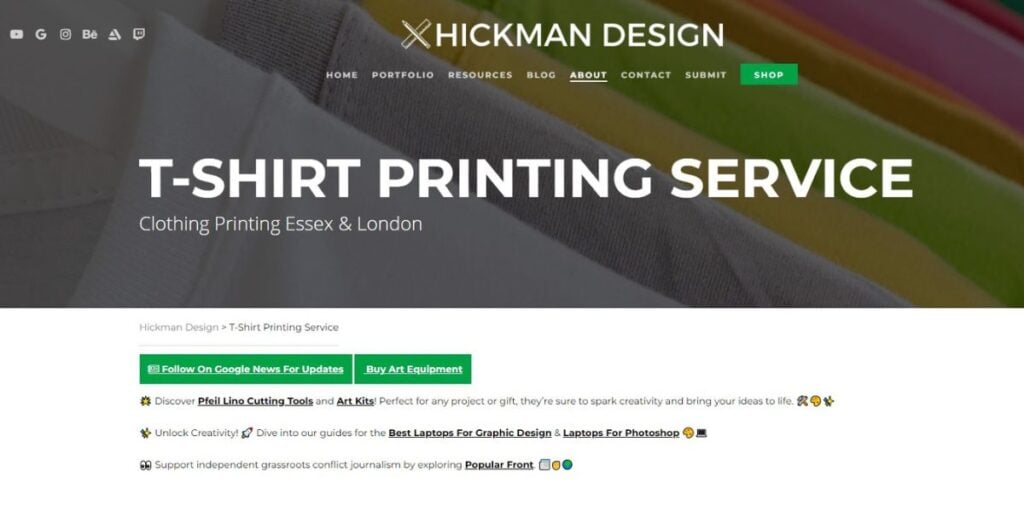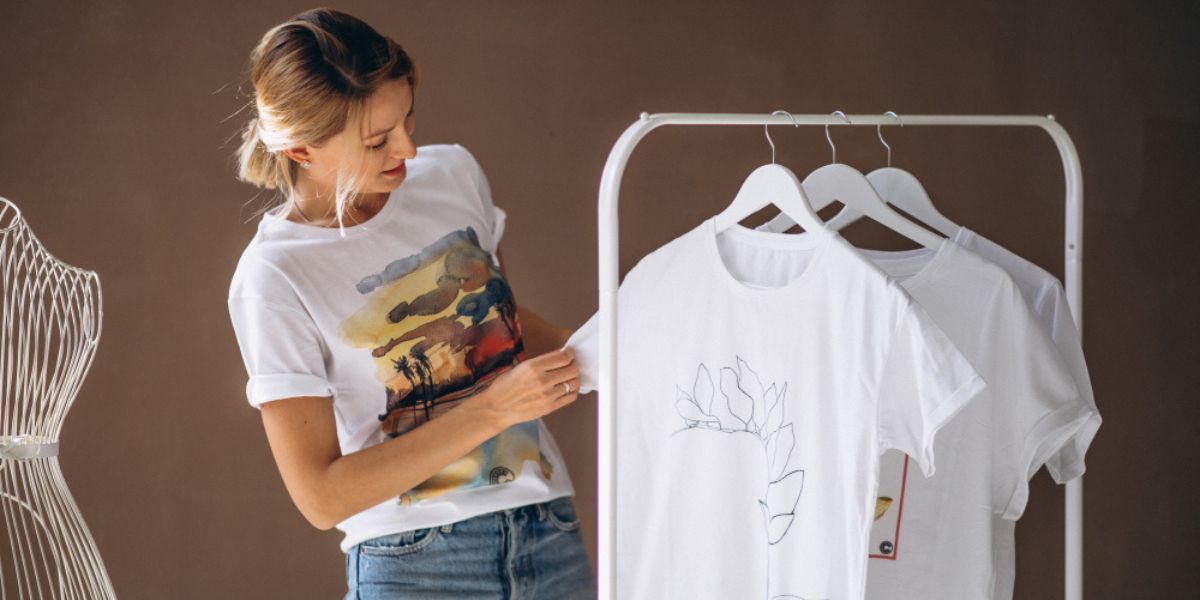Disclosure Sponsored Links: This post contains a paid-for sponsored link, meaning we have received compensation in exchange for including it. Sponsorship does not influence our content, but we believe in transparency regarding paid placements.
We all love T-shirts, right? They’re perfect for festivals, official marches, trendy fashion weeks, and much more. People all over the world are finding new ways to explore with t-shirts and bring new ideas. It keeps up the never ending hype of t-shirt trends.
And from a business perspective, the t-shirt market is growing, and profitable. So, thinking about starting your own t-shirt business is an amazing idea to work on. With global e-commerce sales and print-on-demand technology, there’s never been a better time to jump into the t-shirt business.
But starting a profitable t-shirt business isn’t just about creative designs on t-shirts. It’s about understanding your category, understanding online marketing, and ensuring quality products that make your customers return to you.
In this blog, we’ll walk you through the information about starting your very own t-shirt business. From finding your unique style to the world of e-commerce platforms, we’ve got you covered. Let’s get started.
Table of Contents
Is a t-shirt business still profitable?

Yes, starting a t-shirt business is a profitable venture. The t-shirt market is continuously growing and globally in demand for custom and personalised apparel. According to industry research, the US t-shirt market generated $38.88 billion in 2022.
And it is going to reach $50.59 billion by 2027, following the popularity of online shopping and unique designs. Along with custom t-shirt designs too. Since it offers high-profit margins, typically between 30% to 60%, especially when using print-on-demand (POD) services that minimise overproduction and inventory waste.
Customers tend to go for personalised t-shirts featuring quirky slogans, favourite quotes, or eco-friendly messages. Selling online through platforms like Amazon, Etsy, and Shopify, combined with social media marketing. It allows for easy global reach and customer base growth. So, If you are eager to start your own t-shirt business, let’s jump into the next section and scan throughout the blog onward.
How to Start an Online T-Shirt Business
It’s always easy to give a quick start to the online t-shirt business. All you need to grab is the steps and some essential information to follow through and make the best out of it. Here are the crucial steps you need to follow for starting your own t-shirt business whether it’s online or offline.
Understand the T-Shirt Business Market
 To start the T-shirt business you need to first understand the market. Start by identifying your niche. It could be sustainable fashion, pop culture, or innovative designs, to attract dedicated customers.
To start the T-shirt business you need to first understand the market. Start by identifying your niche. It could be sustainable fashion, pop culture, or innovative designs, to attract dedicated customers.
Stay updated on market trends using tools like Google Trends. Once you’re familiar with the trends and styles then conduct comprehensive market research. Go through social media and competitor analysis to understand your audience’s preferences and behaviours.
Later on, develop your marketing strategy. Implement content marketing to engage your audience, and social media marketing to showcase your products. Also, go for paid advertising for targeted reach, etc to keep customers informed about new releases and offers. That’s how you can slowly align your t-shirt business with the market.
Plan Your T-Shirt Business
Once you secure your market gaps and completely understand the market it’s time to take a step ahead. Create a detailed business plan. Include your goals, target market, marketing strategies, and financial projections.
Design your t-shirts with your audience in mind. Ensure both current trends and timeless fashions are well aligned. Source high-quality materials from reliable suppliers, and possibly look for sustainable options. Set up an online store using a user-friendly e-commerce platform.
Ensure your store is visually appealing and mobile-optimised. Develop a marketing strategy that includes social media, email marketing, and SEO techniques to drive traffic to your store. Launch your business with a promotional event to attract initial customers. Continuously monitor sales, customer feedback, and market trends, and be prepared to make adjustments as needed.
Register Your T-Shirt Business
Registering your T-shirt business is a crucial step. It legitimises your business and ensures compliance with legal requirements. Start by choosing a business structure, such as a sole trader, partnership, limited company, or LLP. Since each one comes with its own benefits and liabilities. For long-term planning, some businesses may also consider structures like an employee ownership trust to align growth with employee engagement and succession planning.
Next, register with HM Revenue and Customs (HMRC) for tax purposes. Sole traders need to register for self-assessment, while limited companies must register with Companies House and HMRC for Corporation Tax. Go for a business bank account. Remember it is essential for separating personal and business finances. It’ll help you in effective financial management.
Protect your brand by trademarking your business name and logo. It’ll prevent others from using them. Depending on your location, you may need specific licences or permits, so check with your local council. Finally, set up an accounting system to track income, expenses, and profits, which is vital for staying organised and simplifying tax filing.
Design Your Own T-Shirt (Create Unique Design)
 It’s time to sit back and go back to your target audience. Whether they are trendy teens, fitness enthusiasts, or fans of niche humour, the knowledge will guide your design choices. Brainstorm ideas by considering current trends, popular culture, and timeless themes.
It’s time to sit back and go back to your target audience. Whether they are trendy teens, fitness enthusiasts, or fans of niche humour, the knowledge will guide your design choices. Brainstorm ideas by considering current trends, popular culture, and timeless themes.
Use tools like Adobe Illustrator, Photoshop, or free options like GIMP and Canva to bring your ideas to life. Focus on simplicity, complementary colours, legible typography, and originality. Test your designs by printing samples to ensure they look good on actual t-shirts and gather feedback.
Once satisfied, finalise your design files in the correct format and resolution for printing. Choose a reliable printing method, such as screen printing, direct-to-garment, or heat transfer. By focusing on unique, audience-relevant designs and effective marketing, you’ll be well on your way to creating a successful t-shirt business.
Choose the Right eCommerce Platform
 Choosing the right eCommerce platform for your t-shirt business is a must. Platforms like Shopify and BigCommerce can handle growth smoothly. Customisation options, offered by WooCommerce and OpenCart, allow you to create a unique store that reflects your brand.
Choosing the right eCommerce platform for your t-shirt business is a must. Platforms like Shopify and BigCommerce can handle growth smoothly. Customisation options, offered by WooCommerce and OpenCart, allow you to create a unique store that reflects your brand.
Since mobile optimisation is essential, with Wix and Squarespace you don’t need to worry about it. For security concerns, Shopify and Adobe Commerce offer tight measures to protect customer data.
Integration with other systems, such as CRM and ERP, is important for smooth operations, and Shopify excels in this area. Strong SEO features, like those in WooCommerce, help your store rank higher in search results. Third-party apps like StoreSEO for Shopify can help you step ahead in this.
Social media integration, available in Shopify and BigCommerce, can boost your marketing efforts. Budget considerations are important, with platforms like Aasaan and WooCommerce offering flexible pricing plans.
Lastly ensure diverse payment options, supported by Shopify and BigCommerce. It ensures a smooth checkout experience for customers. By checking each one of these you can have a scalable t-shirt business.
Source a T-Shirt Manufacturer
Sourcing the right t-shirt manufacturer can be started by researching and shortlisting reputable manufacturers. You can use popular resources like Manufy and Fibre2Fashion. Check the quality of their products by requesting samples, and paying close attention to stitching, fabric weight, and print quality.
Consider their production timelines to ensure they align with your business needs, and compare pricing structures and minimum order quantities to fit your budget. Effective communication is essential, so test their responsiveness and customer service.
Once you’ve gathered all this information, go for the pros and cons of each manufacturer, considering factors like quality, cost, turnaround time, and scalability. After making your choice, ensure that the partnership is a long-term investment in your brand’s success, so take your time to choose wisely with the right manufacturer.
Sourcing Your Fabric
Sourcing fabric for your t-shirt business can be started by listing the type of t-shirts, target audience, and budget. Common fabric choices include cotton for its softness, polyester for durability, and blends for a balance of both. Organic cotton is a sustainable option. You can source fabric online from suppliers by visiting local fabric stores for smaller quantities and expert advice.
Ensure the fabric is consistently available, affordable, and meets your quality standards through functionality testing. Consider eco-friendly fabrics like organic cotton or recycled polyester if sustainability is important. When dealing with suppliers, ask about fabric weight, content, and minimum order quantities to ensure they meet your requirements.
Partner with a POD Company
 When partnering with a Print-On-Demand (POD) company. This model allows you to focus on designing and marketing while the POD partner handles printing, inventory, and shipping. As a result, it will reduce startup costs and financial risk.
When partnering with a Print-On-Demand (POD) company. This model allows you to focus on designing and marketing while the POD partner handles printing, inventory, and shipping. As a result, it will reduce startup costs and financial risk.
With POD partners like Hickman Design, you can concentrate on creativity, ensuring your designs stand out without worrying about unsold stock. It’s also highly scalable. Since it allows you to test new designs easily. Choosing a reliable POD partner is crucial; look for quality products, efficient shipping, good customer service, and fair pricing.
Once you’ve selected a partner, set up your online store on platforms like Shopify or Etsy, create a strong brand identity, and design unique products. Partnering with a POD company simplifies the process, letting you focus on your strengths and build a successful, scalable t-shirt business.
Setting Your Prices
 Setting prices for your t-shirt business involves a careful balance of covering costs and ensuring profitability. Start by calculating all expenses, including the cost of t-shirts, printing, design, packaging, shipping, and overheads. It includes website hosting and marketing.
Setting prices for your t-shirt business involves a careful balance of covering costs and ensuring profitability. Start by calculating all expenses, including the cost of t-shirts, printing, design, packaging, shipping, and overheads. It includes website hosting and marketing.
Aim for a profit margin, commonly around 50%, but adjust based on your market and competition. Research similar businesses to gauge what customers are willing to pay and consider your unique value proposition.
Such as organic materials or exclusive designs, to justify higher prices. Test different price points and be ready to adjust based on sales performance. Offering discounts and promotions can attract customers, but ensure they still allow for profit. Ultimately, setting prices is about creating value for customers while making your t-shirt business sustainable.
Promote Your Products
 It is time to build a strong brand that highlights what makes your t-shirts unique. Use social media platforms like Instagram, Facebook, and TikTok to showcase your designs and engage with followers.
It is time to build a strong brand that highlights what makes your t-shirts unique. Use social media platforms like Instagram, Facebook, and TikTok to showcase your designs and engage with followers.
Create a professional, user-friendly website for online sales and consider adding a blog for SEO benefits. Utilise email marketing to keep customers informed about new products and special offers. Attend local events to showcase your t-shirts and gather direct feedback.
Offer promotions and discounts to attract new customers and encourage repeat purchases. Collaborate with complementary businesses for joint promotions and broader reach. Gather and showcase positive customer reviews to build trust and credibility. Finally, invest in paid advertising on social media and Google to boost your reach.
Analyse Your Performance
Once you start making sales, go for tracking your sales and revenue to identify popular designs and the ones which need improvement. Customer feedback is invaluable. So encourage reviews to understand your strengths and weaknesses.
If selling online, use website analytics to monitor visitor behaviour and identify potential issues with user experience or product descriptions. Social media engagement metrics, like likes and shares, can reveal the effectiveness of your marketing strategy.
Effective inventory management prevents overstocking or understocking. Ensure proper stock levels. Regular financial analysis, including profit and loss statements and cash flow, helps identify areas to cut costs and improve profitability.
Market Your T-Shirt Business
 To start marketing your t-shirt business you first need to understand who your customers are and make your strategies to their preferences. Create a professional, mobile-friendly website with high-quality images and detailed descriptions.
To start marketing your t-shirt business you first need to understand who your customers are and make your strategies to their preferences. Create a professional, mobile-friendly website with high-quality images and detailed descriptions.
Collaborate with influencers to boost visibility and credibility. Offer promotions and discounts to attract new customers and encourage repeat purchases. Make a unique presentation of your t-shirt products in clear crisp images.
Use professional services like ghost mannequin effects to make your product look realistic. Also, apply background removal services to create a clean t-shirt image for your customers.
Continuously innovate by staying updated with trends and listening to customer feedback. Consistency in these efforts will help you successfully market your t-shirt business and stay ahead of the competition.
Prep for Great Customer Service
Prioritise quality in materials, printing, and packaging to ensure customer satisfaction. Clear communication is essential. Provide detailed product information and be transparent about shipping. Add a personal touch with handwritten notes or small freebies to make customers feel valued.
Ensure efficient order fulfilment and partner with reliable shipping companies. Simplify returns and exchanges to enhance customer trust. Maintain responsive customer support to address queries promptly.
Gather and act on feedback to continuously improve. Build a community around your brand through social media engagement and loyalty programmes, turning customers into advocates. Stay updated with industry trends to keep your offerings fresh and competitive.
Frequently asked questions about t-shirt business
What type of T-shirt sells best?
Basic cotton t-shirts in classic colours like white, black, and grey tend to sell best. Graphic tees with trendy or niche designs also perform well, especially when targeting specific audiences.
What printing techniques are commonly used for T-shirts?
The most common t-shirt printing techniques are screen printing and direct-to-garment (DTG) printing. Other popular methods include heat transfer, sublimation, and embroidery, each with its own advantages for different designs and quantities.
How can I market my T-shirt brand for organic growth?
Focus on building a strong social media presence and engaging with your target audience through high-quality content and community interaction. Optimize your website for SEO, collaborate with influencers, and offer customisation options to differentiate your brand and attract customers organically.
Conclusion
So, starting a profitable t-shirt business is a real possibility with the right approach and mindset. With persistence, creativity, and a willingness to adapt, you can build a t-shirt business. Whether you’re targeting a specific niche or aiming for mass appeal, the key is to be flexible in your strategies. As you start on this journey, keep learning, stay connected with your customers, and work on their feedback. Good luck!
Author Name: Luisa Bell
Author Image:
 Author Bio: Luisa Bell is a skilled content planner and writer who has worked in photography and e-commerce content for over six years. With a passion for writing interesting stories, she is great at giving audiences information that sticks with them. Luisa is a great addition to the Masking Aid team because she is dedicated to her work and strives for excellence.
Author Bio: Luisa Bell is a skilled content planner and writer who has worked in photography and e-commerce content for over six years. With a passion for writing interesting stories, she is great at giving audiences information that sticks with them. Luisa is a great addition to the Masking Aid team because she is dedicated to her work and strives for excellence.








